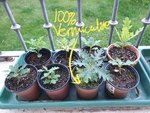In November I collected about 50 acorns of Pyrenean oak and 10 English oak. I first germinated them all in humid kitchen tissues in a sealed plastic bag, and planted each one only when its root was about half an inch or more. Nearly all the acorns germinated. So many that I could experiment a bit with the soil. I put a few in 100% peat, then 20 with about 20% vermiculite 80% peat, another 20 with 50% vermiculite/peat, then about 10 with 33% vermiculite + 33% cat litter +33% peat. Finally, for my amusement I put the last Pyrenean oak in 100% vermiculite.
I also added oak root fungus to about half of each batch, from the roots of a Portuguese oak while I repotted that. To see if this makes a difference at early stage.
You know what? They're all growing well. No discernible difference between the major groups. No clear advantage of adding the mycorrhizal fungus. Although within the groups some have grown taller/faster, or bigger leaves than others, but not correlated to the factors that I imposed.
Amazingly, the 100% vermiculite is growing one of the best of all. (Maybe I should have tried a bigger batch of those.) Also interesting, this one has grown moss sooner than the others, not through anything I did intentionally.
Conclusion: the soil doesn't matter in the first year... it's more about the conditions; light, watering and fertilizer, than the soil.
They're all in full sunlight for about half the day, with watering twice a day now it's getting hot here. I'm using a cheap generic liquid fert every 10 days.
Next March or so I will repot them into larger pots in cat litter / pine bark mix. I won't use expensive bonsai soil for probably 5 or so years.




